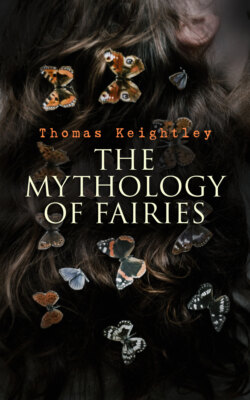Читать книгу The Mythology of Fairies - Thomas Keightley - Страница 19
На сайте Литреса книга снята с продажи.
SCANDINAVIA.
ОглавлениеTable of Contents
De vare syv og hundrede Trolde,
De vare baade grumme og lede,
De vilde gjöre Bonden et Gjæsterie,
Med hannem baade drikke og æde.
Eline af Villenszov.
There were seven and a hundred Trolls,
They were both ugly and grim,
A visit they would the farmer make,
Both eat and drink with him.
Under the name of Scandinavia are included the kingdoms of Sweden, Denmark, and Norway, which once had a common religion and a common language. Their religion is still one, and their languages differ but little; we therefore feel that we may safely treat of their Fairy Mythology together.
Our principal authorities are the collection of Danish popular traditions, published by Mr. Thiele,122 the select Danish ballads of Nyerup and Rahbek,123 and the Swedish ballads of Geijer and Afzelius.124 As most of the principal Danish ballads treating of Elves, etc., have been already translated by Dr. Jamieson, we will not insert them here; but translate, instead, the corresponding Swedish ones, which are in general of greater simplicity, and often contain additional traits of popular belief. As we prefer fidelity to polish, the reader must not be offended at antique modes of expression and imperfect rimes. Our rimes we can, however, safely say shall be at least as perfect as those of our originals.
These ballads, none of which are later than the fifteenth century, are written in a strain of the most artless simplicity; not the slightest attempt at ornament is to be discerned in them; the same ideas and expressions continually recur; and the rimes are the most careless imaginable, often a mere assonnance in vowels or consonants; sometimes not possessing even that slight similarity of sound. Every Visa or ballad has its single or double Omquæd125 or burden, which, like a running accompaniment in music, frequently falls in with the most happy effect; sometimes recalling former joys or sorrows; sometimes, by the continual mention of some attribute of one of the seasons, especially the summer, keeping up in the mind of the reader or hearers the forms of external nature.
It is singular to observe the strong resemblance between the Scandinavian ballads and those of England and Scotland, not merely in manner but in subject. The Scottish ballad first mentioned below is an instance; it is to be met with in England, in the Feroes, in Denmark, and in Sweden, with very slight differences. Geijer observes, that the two last stanzas of 'William and Margaret,' in Percy's Reliques, are nearly word for word the same as the two last in the Swedish ballad of 'Rosa Lilla,'126 and in the corresponding Danish one. This might perhaps lead to the supposition of many of these ballads having come down from the time when the connexion was so intimate between this country and Scandinavia.
We will divide the Scandinavian objects of popular belief into four classes:—1. The Elves; 2. The Dwarfs, or Trolls, as they are usually called; 3. The Nisses; and 4. The Necks, Mermen, and Mermaids.127
